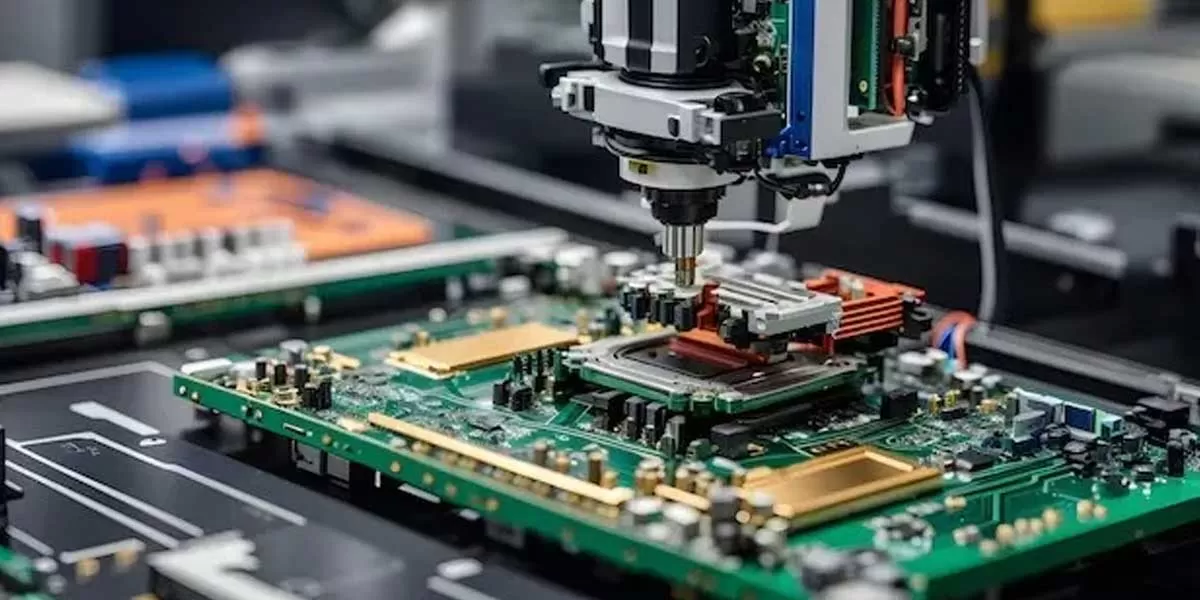
How India Plans to Deepen Local Value Addition in Electronics Manufacturing
Introduction:
India’s aspiration to become a global hub for electronics manufacturing has taken a strategic turn with a renewed focus on deepening local value addition. After successful initiatives that localized smartphone assembly and improved electronics exports, the Indian government is now shifting its focus to developing a robust component ecosystem. This move is vital not only for self-reliance but also to reduce dependency on nations like China and enhance India’s position in the global value chain.
Why in News?
The Indian Government, in April 2025, notified a new ₹22,919 crore incentive scheme for electronics components. The scheme is aimed at pushing India’s manufacturing capabilities beyond mere assembly to producing crucial components such as semiconductors, resistors, capacitors, and more, thereby enhancing domestic value addition.
Point-wise Summary of the Article:
- Background and Shift in Focus:
- India has emerged as a preferred destination for global electronics giants like Apple and Samsung due to its:
- Large talent pool
- Government subsidies
- Strategic geopolitical location
- Earlier success: India localized smartphone assembly and began exporting certain models.
- Current shift: Focus has moved from assembly to value addition in components manufacturing.
- The ₹22,919 Crore Scheme:
- Announced by the IT Ministry in April 2025.
- Aims to incentivize the production of core electronics components.
- This is an extension of earlier Production Linked Incentive (PLI) schemes that mainly supported assembly operations.
- Role of the Semiconductor Mission:
- The India Semiconductor Mission will:
- Provide ₹76,000 crore for fabrication and packaging.
- Allocate ₹23,000 crore under the new scheme for component manufacturing.
- The Objective – Key Target:
- Increase domestic value addition from the current average of 15-20% to 35-40% in the next three years.
- Reduce reliance on Chinese imports which dominate global supply chains.
- Employment and Economic Impact:
- The new scheme is expected to:
- Generate production worth ₹4.56 lakh crore.
- Create 91,600 direct jobs.
- Attract investments worth ₹59,350 crore.
- Import Reduction:
- Import of critical components is expected to decrease significantly.
- Sectors like mobile phones, laptops, automotive electronics, and household appliances will benefit.
- Focus on Specific Components:
- Targeted components include:
- PCB assemblies
- Semiconductors
- Camera modules
- LED chipsets
- Resistors, capacitors, connectors, etc.
- Industrial Participation and Subsidy Mechanism:
- Entities can claim subsidies based on:
- Job creation
- Investment amount
- Production value
- Performance-linked subsidy ensures genuine participation.
- PLI Scheme Performance (Smartphones):
- ₹10,905 crore invested so far.
- ₹7.15 lakh crore production generated.
- ₹3.90 lakh crore in exports.
- Created 1.39 lakh jobs.
- PLI Scheme Performance (Laptops and Computers):
- ₹10,365 crore worth of products manufactured.
- ₹522 crore in exports.
- 5,132 new jobs created.
- Outlook:
- The smartphone PLI scheme is among the most successful.
- Laptop and IT hardware schemes are catching up after a late start.
- Contracts with major companies like Tata Electronics, Pegatron, and Foxconn have boosted interest.
Explanatory Notes:
Key Terms and Concepts:
- Value Addition:
- The process of increasing the economic value of a product by modifying it, such as assembling or adding components.
- Production Linked Incentive (PLI) Scheme:
- A government initiative offering incentives to companies based on their incremental sales and production capacity.
- India Semiconductor Mission (ISM):
- A government initiative aimed at building a robust semiconductor ecosystem in India.
- Components Ecosystem:
- The industry involved in manufacturing parts and subassemblies that go into finished electronic goods.
- PCB (Printed Circuit Board):
- A board used in electronics to mount components like microchips and connectors.
- Import Dependence:
- A situation where a country relies heavily on imports for a particular commodity or product, weakening its self-sufficiency.
- Geopolitical Headwinds:
- International political or economic events that can hinder business or economic activities, such as trade tensions between India and China.
Relevance for CLAT 2026 Aspirants:
- This topic is significant from both the Current Affairs and Legal Reasoning perspective.
- Questions may be framed on:
- India’s economic policies for self-reliance.
- Understanding of schemes like PLI and ISM.
- Implications of global trade and localization on Indian law and policy.
- Aspirants must be able to critically analyze:
- Government interventions in the economy.
- Public-private partnerships in tech growth.
- India’s comparative advantage in the electronics sector.
CLAT Gurukul Notes for Aspirants:
This article and policy highlight the Indian government’s broader commitment to Atmanirbhar Bharat (self-reliant India), a key topic for competitive examinations.
At CLAT Gurukul, we cover such topics extensively in our daily current affairs, legal reasoning sessions, and essay/discussion classes. Whether you’re reading this for understanding economic policy, or to answer a comprehension or critical reasoning question, our curated content ensures that you stay one step ahead in the preparation journey.
Conclusion:
India’s plan to deepen its local electronics manufacturing capabilities is not just a policy move—it is a strategic leap toward technological and economic self-reliance. With global dynamics pushing companies to diversify supply chains, India is positioning itself as a strong alternative with a supportive policy regime. The ₹22,919 crore component scheme marks a significant step in reducing import dependency and boosting the domestic economy, especially at a time when digital infrastructure and electronic consumption are at an all-time high.
Keywords for SEO (CLAT Gurukul Website):
- best online coaching for CLAT
- online coaching for CLAT
- Best CLAT Coaching in Patna
- Best CLAT Classes in Patna
- India electronics manufacturing 2025
- ₹22,919 crore electronics component scheme
- PLI scheme explained
- India Semiconductor Mission
- CLAT current affairs April 2025
- self-reliant India electronics policy
- value addition in electronics manufacturing India
- CLAT legal reasoning economic policy
Note
- This Blog is Powered by CLAT Gurukul — India’s Premier Law Entrance Coaching Platform
At CLAT Gurukul, we are dedicated to nurturing the next generation of legal professionals through a powerful blend of expert mentorship, strategic preparation, and high-quality content. This blog reflects our commitment to offering aspirants not just updates — but understanding, not just information — but insight.
Why Choose CLAT Gurukul?
- Personalized Guidance from Top Legal Mentors
- Comprehensive Study Resources & Legal Updates
- Daily Practice Sets, Mock Tests & Progress Analysis
- Result-Oriented Preparation Strategy for CLAT, AILET & CUET
Whether you’re here to sharpen your current affairs, brush up legal reasoning, or boost your comprehension skills — you’re already one step ahead with CLAT Gurukul.
Join the success stories of thousands of toppers who trusted us and cracked India’s toughest law entrance exams.
Visit www.clatgurukul.in to explore our full offerings or speak directly to our expert team.
- A Note from Team CLAT Gurukul
We at CLAT Gurukul are committed to providing free, high-quality CLAT study material to support all serious aspirants, regardless of background.
Our content includes:
- CLAT Current Affairs
- Legal Reasoning Practice Passages
- Static & Dynamic General Knowledge
- Logical Reasoning Exercises
- English Comprehension Practice Sets
All our material is curated by experienced mentors and regularly updated to reflect the latest CLAT UG pattern.
Open-access learning is our core philosophy. We believe that every student deserves the right guidance — and we aim to deliver that, free and consistently.
Explore our blog by topics like:
Best Online Coaching for CLAT
CLAT Legal Reasoning & Updates
CLAT GK & Current Affairs
CLAT Logical Reasoning Practice
CLAT English Section Preparation
For complete access to structured courses, expert mentorship, and test prep tools, visit www.clatgurukul.in — The Best CLAT Coaching in Patna and India’s Trusted Online CLAT Prep Platform.
- For CLAT Legal Reasoning Blog Readers:
Looking to master legal reasoning for CLAT 2026? Our blog posts include:
- Legal reasoning practice questions based on case laws
- Constitution and statute-based passages
- Detailed explanations and logical application tips
All content is crafted in alignment with the official CLAT syllabus, incorporating recent Supreme Court judgments, amendments, and relevant legal updates.
Explore topics under:
CLAT Legal Reasoning PDFs
Case-Based Legal Questions
CLAT Legal News Capsules
Best Online Coaching for CLAT
📲 For access to full-length mocks, live classes, and personalized mentoring, visit www.clatgurukul.in — India’s Top-Rated CLAT Online Coaching Platform.
- For CLAT Current Affairs & GK Blog Readers:
Stay up to date with daily and monthly CLAT GK capsules, including:
- National & International Current Affairs
- Legal and Policy Updates
- Economic, Environmental & International News
- Static GK & Constitution-based Facts
Our monthly compilations and legal GK explainers are crafted to boost your retention and CLAT-specific knowledge.
Explore categories like:
CLAT Current Affairs 2025–26
Legal GK & Landmark Amendments
Free CLAT GK PDFs & Notes
Toppers trust www.clatgurukul.in for CLAT-specific General Knowledge preparation. Join them and take the next step toward your law career.
- For CLAT Logical Reasoning Blog Readers:
Master the Logical Reasoning section with our expertly curated content:
- Argument & Assumption Based Practice Sets
- Inference, Strengthening/Weakening & Conclusion Questions
- CR Passages Based on the CLAT Pattern
Improve your analytical thinking, comprehension speed, and exam accuracy.
Popular blog categories include:
CLAT Logical Reasoning
Statement-Conclusion Drills
Critical Reasoning for CLAT 2026
Free Reasoning PDFs & Questions
For targeted mentorship, structured practice, and expert strategy — log on to www.clatgurukul.in, India’s Most Trusted CLAT Online Coaching Platform.
Ready to elevate your CLAT prep?
Visit 👉 www.clatgurukul.in — or WhatsApp us at 📲 +91-7033005444 to speak to our academic advisors.






